 Sora Yori mo Tooi Basho. I found that the pilot was composed very well, and at this time the show has only just started, so you can perhaps think about what we’ve talked about today as you follow the show and see if it holds up. Sora Yori mo Tooi Basho. I found that the pilot was composed very well, and at this time the show has only just started, so you can perhaps think about what we’ve talked about today as you follow the show and see if it holds up.
You should definitely watch Sora Yori mo Tooi Basho before we start, not only because I’ll be referencing it a lot but also because it’s a really solid episode of anime that’s worth your time. In summary, though, we have a bunch of girls who want to go to Antarctica for various reasons. It’s simple, it’s clean. If we were to divide such a story into three acts, it will, in the most skeletal fashion, go something like this:
That’s all fairly straightforward, no? But anime is divided into more than just acts; they are divided into episodes, and each episode (or episode arc) can also follow the three-act structure as well. Did you find the first episode of Sora Yori mo Tooi Basho oddly satisfying? I did, and that’s because it goes through all three acts and is, in itself, complete. Like this:
See? That’s a complete story right there. It makes for a satisfying episode. You’ll find that the three-act structure, or something resembling it, is used almost everywhere, because what the three-act structure does, in its most general terms, is describe the rise and fall of tension. Throughout a story, tension starts low in the first act, builds to a crescendo in the second act, then peaks in the third act and rapidly drops again. That’s just a natural way to do it; high tension cannot be sustained all the time lest the audience get burnt out and numb, and so instead we settle lulls punctuated by occasional spikes to maintain interest. And when we look closely at our anime and start to break it down we’ll this up and down, rollercoaster of tension that is the foundation of the three-act structure — what I personally refer to as ‘set-up’, ‘build-up’ and ‘release’ — is everywhere. We see it in the overall arc of the series. We see it in each episode. We see it in every scene:
Digging even deeper, even one shot can be broken up like this:
The Japanese actually have a name for this: jo-ha-kyuu (序破急). When transliterated it means, roughly, ‘beginning-break-rapid’, and describes an artistic aesthetic that’s analogous to the three-part structure we’ve been talking about — begin slowly, ramp to a climax, ending with a swift resolution. That’s their version of their tension curve, and it permeates all Japanese arts, from theatre to poetry and beyond. And of course, as we’ve seen it’s in anime as well. I know I often make a big deal about anime being a uniquely Japanese medium, but it’s fascinating how there’s this universal quality to storytelling as well. So, as you watch Sora Yori mo Tooi Basho, and other shows this season, keep an eye out for the three-act structure. Not all stories will follow it to the letter, but you might also be surprised by how many do, on every level. 19 CommentsLeave a Reply |




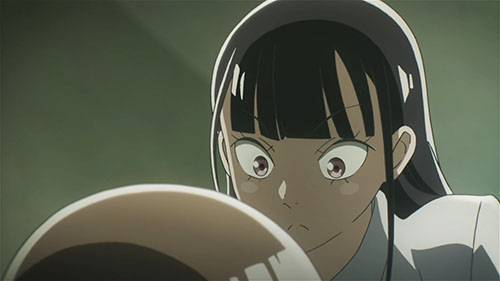
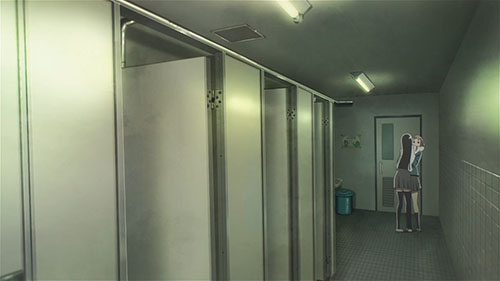
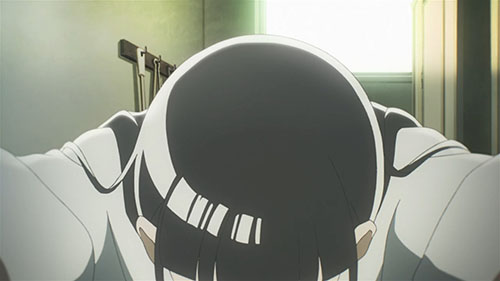
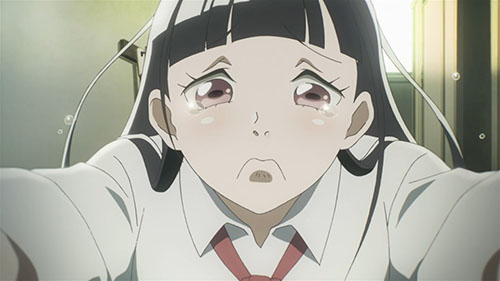
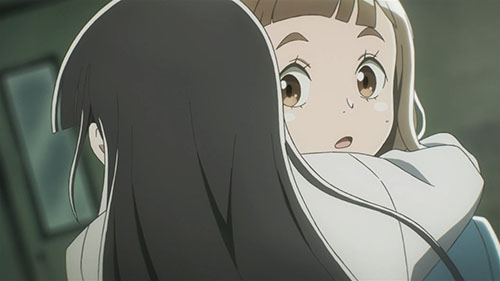
Sadly, so true —
I took creative writing in HS, and I do not recall a single lesson on any
of the mechanics of “creative writing” – you were expected to just “know”
how to write creatively. But I digress…
But I agree with your analysis — very insightful.
Another example in this series was when Shirase is being bullied and
Mari “steps in” to rescue her. I can see it now, though while watching
that part I wasn’t thinking about the “Three-Act” technique at the time.
Around here there was a phase in English education—which perhaps continues to this day, I don’t know—where they drew back from teaching many formal rules and instead wanted students to just ‘write how they feel’.
you call it “Set-Up, Build-up and Release”
i would call it “ebb and flood”, yes the Tidal movements, or every action needs space to relax
Also most of classic Music and today music have an introduction, main theme and end part
As you see. this 3 parts are everywhere if you want to look for it. Also some Writing Story’s haven Introduction, Main part and “finale” (you of all here should know that)
But i like more the water explanation. Because Water is life, and it finds its own way
myself did not learn anything about writing. it is just that i watched many animes, read mangas (well only the translate of course) and even “Hollywood” Movies are build nearly all the same.. But also old Classic music…
Yes, Music have nearly the same structure
For classical music, we specifically have the three part sonata form – exposition, development, recapitulation. For those not familiar with sonata form, the exposition usually introduces two themes in different keys to introduce some tension. The development takes elements of those themes and builds on them, and finally the recapitulation repeats the themes but this time in the same key to provide a resolution.
Jo-ha-kyuu is actually a fundamental aesthetic in a lot of Japanese music. They take this stuff pretty seriously.
A very interesting post that gave me a better understanding on this series so far.
while I usually stick to the old but gold “three episodes rule” this time Sora Yori mo Tooi Basho already captured my heart at episode 1 like many other people I bet, and it’s thanks to the “three-act structure” you described so good which works obviously very well.
At first I thought it sounded pretty basic and plain when Tamaki Mari said she would like to make the best out of her youth, but I have to say it’s quite charming and utterly relatable, as for Shirase I think that it doesn’t have to be Antarctica. They could go to every other place and I would still like the idea of them going somewhere that won’t be easy to reach for them – and I would still rooting for them anyway.
I really like the girls so far and they showed so many differet expressions already and the running scene in episode 2 was a good way to keep me excited for more moments like these. I think the series just set it’s expectation bar quite high.
I admit, with Episode 1 and 2 i have also a little bit of K-On OAV Vibes.. the “slice of Life” is somehow the same for me
It goes to show, I think, that it matter less what story you are telling, as long as you tell it well.
I really wouldn’t mind seeing more staff produce posts like these. I think if you have something worthwhile to talk about or explain, you know, something you care about and want to share, go for it. If it’s anime related, why not?
I think it’s mainly because these posts are a fair bit of work, ha ha. It’s often hard to find the time to do them on top of our regular episodic coverage.
I thought this post exist because AUSTRALIA :)))
(Sorry Passerbay-dono)
-but then again they’ll die not because of hypothermia at the south pole in 9th Episode. But more like because the spider when they try to pass through OZ.
or croco
or snek
or birbs
or koala, really, anything kills in OZ.
Nice topic!
I think one of the most beautifully obvious (in a good way!) three act set-ups is in Fullmetal Alchemist. Not the BONES version but the original manga/Brotherhood version is a very well done example of three clearly defined phases which made the overall story arc unusually satisfying. As the manga was being published, various factions of fandom fell into the pit of “doom” at the end of Act Two which, of course, is the story nadir. You’re supposed to feel the doom! But seeing how clear the three act formula was being followed, I was confident in an optimistic resolution.
We can ponder the value of prediction in storytelling. Contemporary audiences have become quite sophisticated and claim to be hungry for convention-busting plots. We’ve seen a variety of series try to surprise us but they often become a muddled mess. That series (last year?) about the rumored missing-people village is a great example. It seemed viewers felt let down when the show went sideways from their expectations. Westworld is a terrific example of a TV series in which the writers tried to challenge a sophisticated internet/cable-TV audience and failed miserably because they severely underestimated how intelligent and exacting that audience now is.
Perhaps both shows did follow the three act rule but I didn’t really notice if either did or not since the main intention of the shows was to focus on other things, namely, surprising us. But is the “surprise” better than following a clear and well-tread path?
Supposedly we want to be surprised and shocked; we want someone to show us what we can’t imagine and expect. But research is suggesting that we actually experience a mental and emotional mood-boost from being able to successfully make a prediction about something we’re engaged with (music is the most researched example AFAIK). Our minds are always trying to game out our current situation; it’s a natural safety precaution. We are more likely to keep ourselves safe if we can correctly judge likely outcomes or events. This carries over into our storytelling.
The most successful stories are fundamentally built on the three act structure. This gives us a nice internal lift when we can rely on “here is the world, here is the problem, here is the resolution.” Encase this structure within a well-realized world following consistent rules, populated by complex and dimensional characters facing a problem of some importance and you’ve got a happy audience. These other elements are critical; the three act set-up isn’t enough and there does need to be some sense of the “new” but perhaps the foundation of a plot isn’t where you want to mess around too much.
Sounds simple, right? Ask George Lucas. Star Wars is not only one of the biggest and most successful story franchises ever, it’s almost painful how obvious the three act structure is. Trilogies are more common and more successful than duologies for a reason!
For anyone previously unfamiliar with the concept, once you’ve seen it, you can’t unsee it. Now enjoy finding the low/turning point in everything you watch.
Thanks for the topic! 🙂
Thanks for reading, and thanks for input! I think the thing about story structure is that human beings have a fundamental understanding of how stories should go. We are exposed to stories of all kinds from childhood, and it is from them that we gain implicit comprehension of logic and causality. If one were to deviate from a set structure — and one certainly can, with skill — there should be a good reason to do so. Is surprise a good enough reason? Perhaps that’s best left to be judged on a case by case basis.
Even if the flow of a story is predictable, the content could be a different matter, though. For example, the third act resolution need not be a happy one. Comedies, tragedies and epics all have their own conventions and their own forms, but that will have to be a topic for another time.
Interestingly, this is probably also the origin of the “Three Episode Rule”.
A little googling got me this page on the overall timing of a movie script: http://www.movieoutline.com/articles/the-five-key-turning-points-of-all-successful-movie-scripts.html
Act 1
-Setup
->10% — Opportunity
-New situation
->25% — Change of plans
Act 2
-Progress
->50% — Point of no return
-Complications/Higher stakes
->75% — Setback
Act 3
-Final push
->90%-99% — Climax
-Aftermath
Act 1 covers 0%-25%, Act 2 is 25%-75%, and Act 3 is 75%-100%. There’s also additional inflection points within each act — at 10% within Act 1, at 50% within Act 2, and around 90%-99% in Act 3. However the key point of interest is: What is the 25% point (the end of Act 1) of an anime series?
With a movie, it’s all self-contained, but with an anime TV series, it’s nested. As described in the article above, whether it’s the entire series, or each episode, or each scene, we see this pattern emerge time and time again. And for anime, there is a very specific larger unit that they all use: the cour, or season.
Winter, Spring, Summer, and Fall. Every series is broken up into units that fit into those seasonal categories, running somewhere between 10 and 14 episodes, with 12-13 being the most common. What about longer series? Well, 24-26 episodes is two seasons. For example, The Magus’ Bride is a 24 episode series. A series will rarely run for 3 seasons (39 episodes), which generally leads to a shortened Act 2 (similarly to movie trilogies and the like). Some will run for an entire year (52 episodes), such as Cross Game at 50 episodes, and Magic Knight Rayearth at 49 episodes.
And what we see is that longer-running series can be broken up in the same way. A year-long series will use the first season as Act 1, the second and third seasons as Act 2, and the fourth season as Act 3. Yet each of those seasons (or just an ordinary single-season series) is itself a three-act event. A two-season (26 episode) series will have a somewhat more complicated set of overlapping effects, but it’s still pretty easy to see how it will end up getting laid out overall.
And within each season, those acts are delineated by episodes: Act 1 in the first 25% (episodes 1-3); Act 2 in the next 50% (episodes 4-9); and Act 3 in the final 25% (episodes 10-12). If you look at how much it might vary as the number of episodes changes, 10 episodes gives Act 1 ending at episode 2.5, and 14 episodes gives Act 1 ending at episode 3.5. Fitting that to usable units, you still end up with Act 1 covering to the end of episode 3.
And thus, the Three Episode Rule. Summarized in writing concepts: Watch the first act, up to the point where the second major turning point occurs. That second turning point is where the story changes from its original general premise of opportunity, to a specific goal that is going to define what the remainder of the show is going to try to achieve. If that goal doesn’t hold you, then the rest of the series won’t, either.
Let’s look at the first episode of Sora Yori. Its length is 23:45. The OP is 2:15 to 3:44 (90 seconds). The ending credits ran on top of the trip they made, so I won’t exclude that. 1425 seconds – 90 seconds = 1335 seconds.
Target points to look at (with OP-adjusted time in parentheses):
134 seconds (10%) — OP starts at 135 seconds in, so this is the portion where we meet Kimari as she wakes up in her room and has her realization.
334 (424) seconds (25%) — @414 seconds, Kimari is back at school, having not gone on her skip day. Her goal has to change.
668 (758) seconds (50%) — @755 seconds, Just completed the crying scene from returning the money, and starting the explanation of Shirase’s mom’s book.
1001 (1091) seconds (75%) — @1103, Shirase offers the flyer to Kimari, asking if she’s willing to actually commit to help.
1201 (1291) seconds (90%) — @1346 (94%), end credits finish, and they’re running on the dock to see the ship.
And we see it pretty much hits the beats on the nose. Yet we also expect that, as the first episode of the season, the episode as a whole only encompasses the Setup/Opportunity phase of the series. And that indeed is what it does. The opportunity chosen is to join Shirase on her attempt to get to Antarctica to find her mom. Yet we can also expect that, by the third episode, this goal will have changed. It will be about more than just the individual reasons each girl in the (eventual) group has for going, but something more concrete for all of them to work towards together for.
Back to the article itself, the really interesting approach is how well you can fit this entire pattern into subsets of episodes. For example, if you take the first three episodes of Madoka Magica as a standalone, the 25% point (75% through episode one) is where Madoka finds the injured Kyuubey, and confronts Homura as a magical girl for the first time (ie: New Situation phase leading up to a Change of Plans). The 75% point is in episode three, where Madoka’s mom comes back home drunk (ie: finishing the Higher Stakes of Act 2 where Kyuubey just explained Madoka’s potential to her, and hitting the Setback inflection point). The 90% point is the “You’re not alone anymore” speech.
You can see more edges of it with Act 2 (eps 4-9) concluding with the Sayaka episode, and then Act 3 leading off with the flashback in episode 10, which very easily fits into a new Act 1 layer, while also being the ‘setback’ of Act 3 of the overall series.
In other words, the entire season follows the three acts; each act (eps 1-3, 4-9, 10-12) follows the three acts; and each episode follows the three acts. Then that continues on down, where each act within each episode can also be described as following the three acts, and so forth.
This leads again back to the Three Episode Rule, where you’re not only seeing Act 1 of the entire series, but you’re also seeing how well the studio can produce the complete three acts within that first act. Individual episodes can also show that, but it depends on how finely-grained their production is, in terms of that story structure, which makes a single episode less reliable of an indicator.
People complain about the “simplicity” of storytelling in some shows, and claim to want to be surprised more (as detailed in danny’s reply), but I’m guessing it’s not surprise that’s lacking, so much as texture. A simple line falling and rising, vs a fractal curve of the same thing, but where each line segment carries its own complexity. A ‘good’ series is one where you can see these patterns arise both close up and far away, and each event contributes to multiple levels. The same event can be part of acts 1, 2, and 3 at the same time, when looked at from different perspectives.
A purely episodic series can’t really achieve this; you need an overall plot. And anime’s seasonal structure gives a very regular pattern to build off of, which is what makes the Three Episode Rule so reliable.
Great analysis! ‘Fractal’ is definitely a good way to put it. Curiously enough, looking at the first three episodes by themselves it is sometimes the first episode that is the second act, with episode two going back to do more of the introductory work. Obviously this is because they want to start exciting to hook viewers, but it might be useful to talk about starting in media res if a show that does it interestingly pops up opportunistically.
It’s great to see such written formal analysis of narrative structure in anime, a field I am very passionate about, and similarly have no formal education in.
The three act structure is a great way to look at any narrative, and is incredibly flexible in terms of the variety of stories which can be made sense through it’s application. Having said that, I find that anime in particular often requires a bit more shoehorning to fit than most works, and perhaps ends misjudged as poorly structured. In these cases I like to look at anime narrative through the “ki-shou-ten-ketsu” 4-part structure (Wikipedia has a brief overview with some slightly obtuse examples, it can most obviously seen in 4-koma though). This often leads to some “AH-HA!” moments as shows which seem weirdly paced (or out of order) for a three act structure become more comfortable to analyse. For example, I found it make much more sense to look at Eva 3.0 knowing that it was just the ten/twist act of the story, and 4.0 will be the ketsu/conclusion (Anno pls).
As a note for anyone interested in looking more deeply into narrative structure; remember that these various ways of looking at stories are just that – tools of analysis, not a litmus test for the validity of a work, and certainly not a blueprint to create a story.
Anyway, thanks for the article, I look forward to seeing more in this vein in the future.
Your “set-up, build-up, release” reminded me of this video:
https://youtu.be/GFI6pvOl3YY?t=2m52s